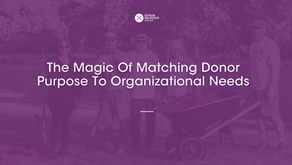A Checklist for Ethical Storytelling: Stirring Hearts, Not Manipulating Minds
- Lynne Wester
- Nov 8, 2023
- 4 min read
Updated: Jun 12

Storytelling is a powerful tool for nonprofits. Our stories can evoke laughter, tears, and deep thought. When told well, stories inspire action and drive change. In the world of nonprofits, the power of storytelling is invaluable.
At DRG, we are dedicated to providing you with a treasure trove of strategies to enhance your storytelling prowess (check out the valuable content we've shared at the bottom of this post).
However, it cannot be said enough: storytelling must be persuasive and ethical. It can actually be a tricky tightrope to walk.
On one hand, we are driven to craft a narrative that is emotion-provoking enough to compel someone to support a noble cause. But on the other hand, we cannot exploit beneficiaries or manipulate donors.
So how do we find that perfect balance?
Well first, I need a quick show of hands – who here has experienced that uneasy feeling after reading a certain solicitation letter or watching a Sarah McLachlan-scored commercial? 🙋🏻♀️
Chances are, in those instances, the storytellers leaned a bit (or perhaps a lot) more toward persuasion than ethics in their strategies.
In order to avoid falling into that same trap, here is a great checklist of Do’s and Don'ts.
The DO’s and Don’ts Checklist
Be respectful. Ethical storytellers prioritize the privacy and agency of their protagonist(s) by obtaining permission to tell their story and use their name, images, and other personal information. If a beneficiary's name cannot be used (but they agree to the story), be sure to change any identifying characteristics in the narrative. Also, when writing someone else's story, always factor in time for approval and edits. When we value their personhood and input, they’re able to ensure their story is told accurately and respectfully. Remember, you are telling the story of a person, not just a “cause.” It is absolutely possible to convey the gravity of a challenge someone faces without robbing them of their dignity.
Be inclusive. Power dynamics often determine whose stories are heard and how they're told. When we are aware of and acknowledge this fact, we can take steps to be more inclusive. Take a bird’s eye view at the collective stories told across your organization. Is it a tapestry of experiences or a monochromatic blob? Ideally, we want that tapestry! When we amplify the voices of marginalized or underrepresented groups, we (and our constituents) challenge harmful stereotypes and gain profound insights.
Be responsible. Be accurate. Be aboveboard. Be authentic. Remember that you will be held accountable for your work, so transparency is key. Consider the potential impact of this narrative on the people involved and those who will be touched by it. To prevent retraumatization, use trigger warnings where necessary.
Don’t sensationalize the suffering of others. Overhyping rarely leads to positive outcomes. Your ‘enhanced’ rendition of the account may be more captivating, but I can assure you that it is not worth losing the trust of your constituents and facing the wrath of “cancel culture.” Instead, prioritize empathy over sympathy to steer clear of condescension or exploitation– craft narratives grounded in compassion and understanding. It's not about making your donor feel sorry for someone - it's about helping them understand and connect with someone else’s struggles and experiences.
Don’t perpetuate negative stereotypes or harmful tropes. Instead, highlight individual experiences. This approach helps us see the nuance and complexity of people's lives and creates a deeper connection with them. When storytelling through data, pay attention to how you present it. The experiences of marginalized groups may be hidden in aggregate data. For example, the San Antonio Area Foundation combats this by using zip codes rather than race or ethnicity in their data representation. This allows them to put the spotlight on the communities and environments in which individuals live rather than reducing them to predefined traits. When we place shared experiences before shared characteristics, we will elevate those we aim to support.
Don’t Fear monger. Fear mongering is the manipulative cousin of conveying what is at stake. Rather than aiming to be informative or helpful, it preys on people’s emotions by evoking fear and panic. Both approaches use the same psychological principle of Prospect Theory: the theory that people are more motivated to avoid losses than to acquire gains. This is why we are more likely to respond to messages that evoke fear or anxiety than to messages that evoke positive emotions (I explored this in more detail in #9 on our list of Clever Strategies to Boost Gift-Giving). However, fear mongering is a perversion of that principle. While there's a legitimate place for emphasizing the importance and urgency of a cause, pushing individuals to act solely out of fear can erode trust.
Key Takeaways
We can move hearts and minds without manipulating or exploiting people. The key questions to ask yourself are:
Am I putting the person first and the struggle second? (Your answer should be “Yes.”)
Am I being manipulative? (Your answer should be “No.”)
Persuasive Strategies
When you perfect persuasive and ethical storytelling, you will craft action-provoking communications that you can feel good about.
And now that you have an understanding of what it takes to be an ethical storyteller, I invite you to skim the following blog posts for specific strategies you can employ to become a more persuasive storyteller:
The Anatomy of a Story: A Roadmap to Clear and Compelling Communications
Behavior Economics in Fundraising: 11 Strategies to Boost Gift-Giving in 2023 - Part 1
Behavior Economics in Fundraising: 11 Strategies to Boost Gift-Giving in 2023 - Part 2
Telling Your Story: 5 Steps to Develop Your Organization's Voice
Marginal Gains for Strategic Donor Relations: Small Steps for Big Impact
By Madelyn C. Jones. Madelyn is passionate about helping nonprofits create communications that cut through the clutter and capture the attention of donors.





